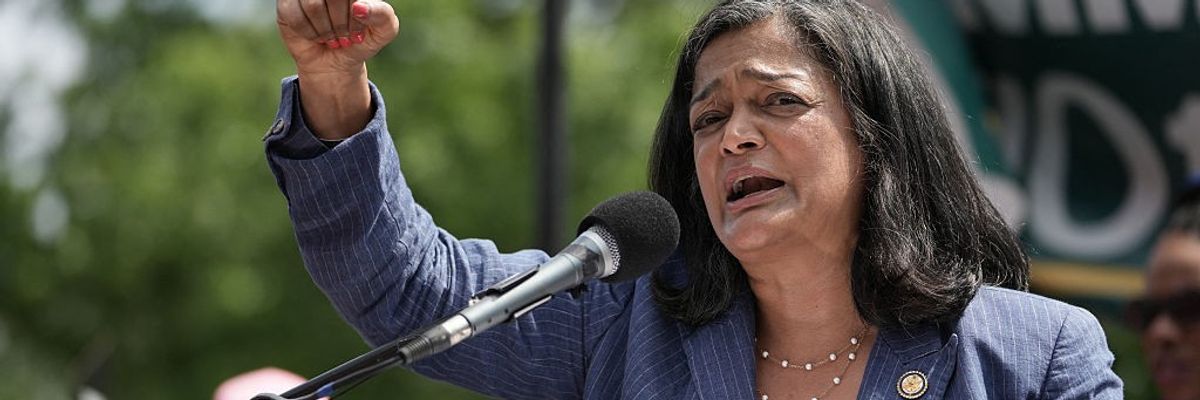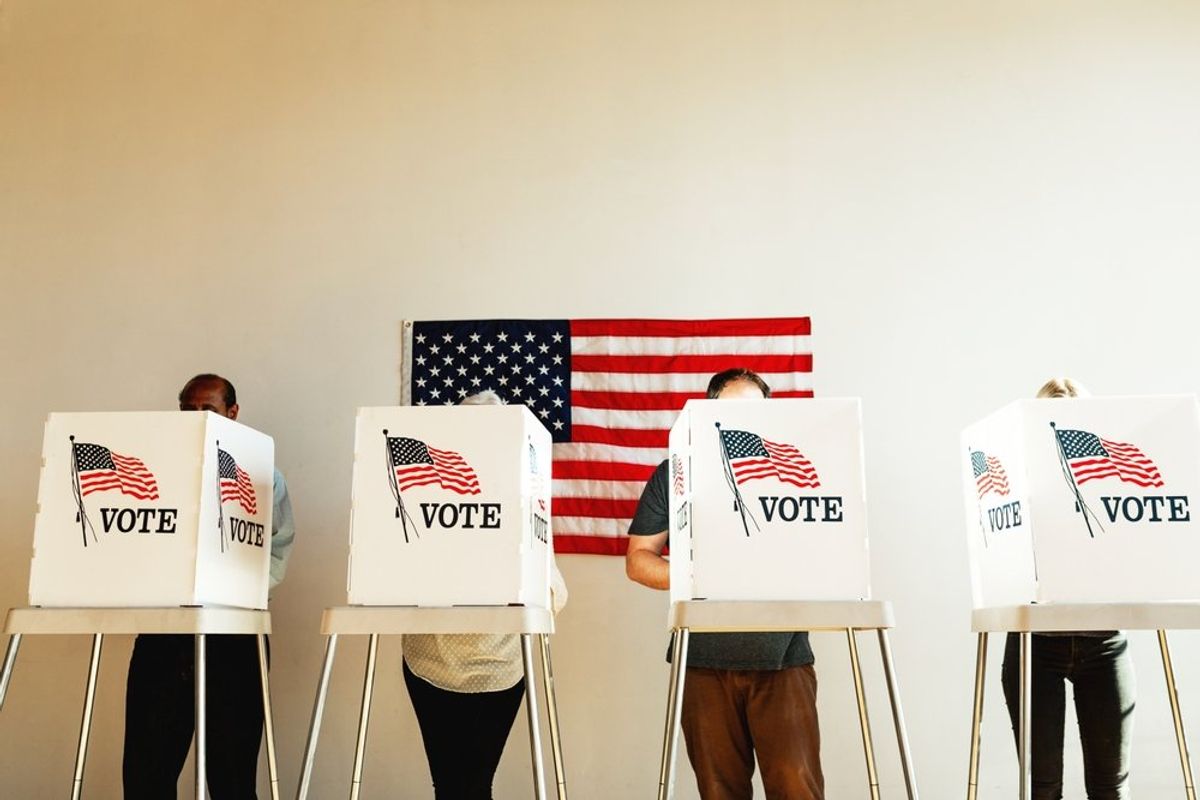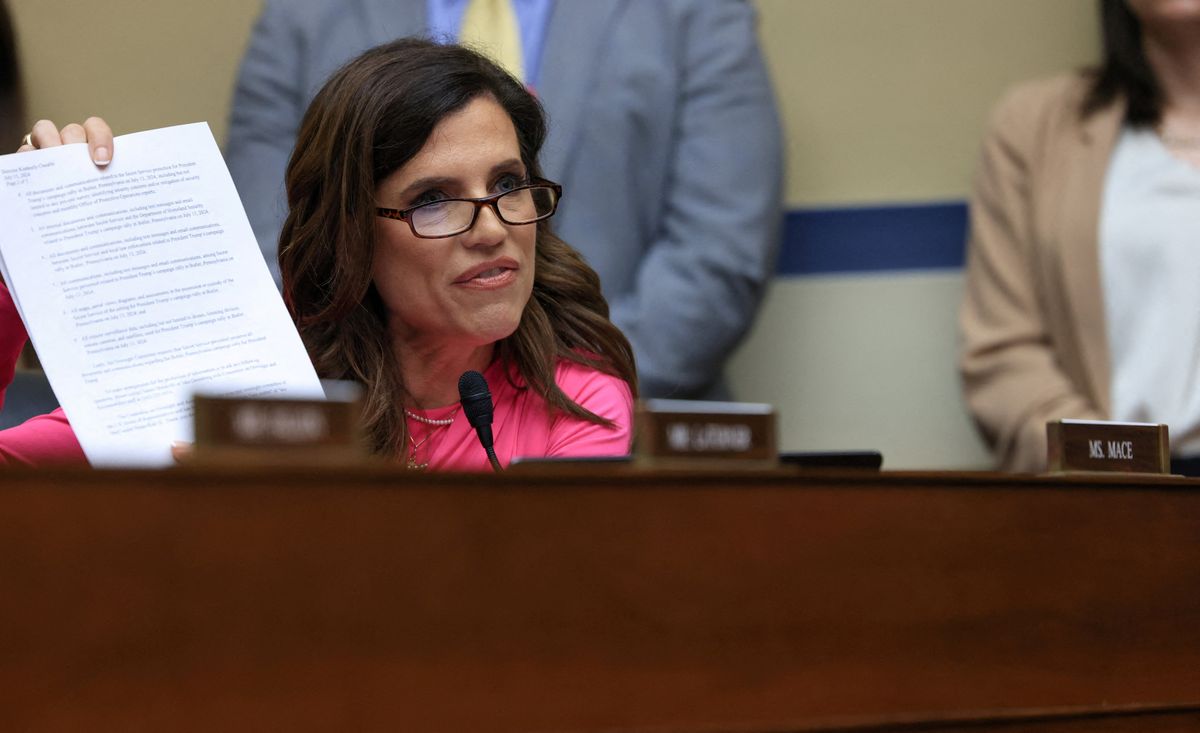Jayapal Slams ICE for Targeting Law-Abiding 'Moms, Dads, Grandparents'—Not Criminals"ICE isn't going after the 'worst of the worst' like Trump promised," the progressive congresswoman said. "They're disappearing asylum-seekers, families, and relatives of citizens—many with no criminal record."

U.S. Congresswoman Pramila Jayapal (D-Wash.) speaks to protesters near the White House in Washington, D.C. during May 1, 2025 rally against the Trump administration's deportation policies.
(Photo: Oliver Contreras/AFP via Getty Images)
Brett Wilkins
Jun 26, 2025
COMMON DREAMS
Progressive U.S. Congresswoman Pramila Jayapal on Thursday hosted a "shadow hearing" on Immigration and Customs Enforcement's targeting of asylum-seekers, families, relatives of American citizens, and other law-abiding people for deportation—policies and practices that belie President Donald Trump's claim that his administration would focus on removing undocumented criminals.
Jayapal (D-Wash.)—the ranking member of the House Judiciary Committee's Subcommittee on Immigration, Integrity, Security, and Enforcement and an immigrant—convened the panel, called Kidnapped and Disappeared: Trump's Weaponization of Immigration Courts. The shadow hearing "examined the disturbing trend of broad efforts to erode access to legal services and due process in immigration proceedings, especially as Immigration and Customs Enforcement (ICE) has been targeting immigrants showing up for legal proceedings—following the requirements set for them by courts."
"These actions are a direct attack on the legal immigration system and the people who are trying to follow all the legal steps."
A sampling of the more than 65,000 people arrested by ICE since Trump reentered office in January reveals people including a beloved resident of a staunchly pro-Trump town, a decorated combat veteran, a child with cancer, anti-genocide protesters, and a woman with an American husband and child who's lived in the U.S. for nearly 50 years.
While the Trump administration claims that "3 in 4 arrests were criminal illegal aliens," most people caught up in Trump's mass deportation drive have no criminal records or have only committed minor offenses including traffic violations. According to the libertarian Cato Institute, 65% of people taken by ICE had no criminal conviction whatsoever and 93% had no conviction for violent offenses.
"Republicans like to talk about how they support immigrants who quote 'do things the right way,'" Jayapal said during the hearing. "Now that they control Congress and the White House, they should be putting their money where their mouth is and ensuring that the legal immigration process remains open to those who pursue it—but that's not what's happening."
"They have arrested people at their citizenship interviews, their check-in appointments with Immigration and Customs Enforcement, and increasingly, at immigration court," Jayapal continued. "These actions are a direct attack on the legal immigration system and the people who are trying to follow all the legal steps."
"These actions only serve to make the immigration system even more chaotic and unjust than it already is," she added. "Just when you think this administration cannot sink any lower, they get out a shovel and keep digging."
House Democrats Judy Chu (Calif.), Jesús "Chuy" García (Ill.), Sylvia Garcia (Texas), Glenn Ivey (Md.), Henry C. "Hank" Johnson, Jr. (Ga.), Zoe Lofgren (Calif.), Jerrold Nadler (N.Y.), Delia Ramirez (Ill.), Mark Takano (Calif.), and Rashida Tlaib (Mich.) took part in Thursday's hearing.
Speakers on Jayapal's panel included retired immigration judge A. Ashley Tabaddor, National Immigrant Justice Center policy director Azadeh Erfani, Acacia Center for Justice chief of staff Bettina Rodriguez Schlegel, andImmigrant ARC interim director of programs Gillian Rowland-Kain.
"Due process in a courtroom means that every part of the system functions fairly and in concert. That requires an independent judge, a level playing field, and a safe, accessible forum for all participants," Tabaddor said. "Yet noncitizens have no right to appointed counsel—even in life-or-death matters."
"Now, the Trump administration claims that immigration judges are effectively at-will employees, directly undermining their independence," she continued. "At the same time, immigration courts are being transformed into enforcement zones, deterring participation and eroding public trust."
"As a former judge, I can tell you: When even one part of the machine breaks—when judges are undermined, when legal support disappears, or fear keeps people from appearing—the entire system collapses," Tabaddor added. "And when that happens, it doesn't just fail immigrants. It fails all of us."
Erfani said: "Nothing is off the table for ICE to meet Trump's arrest quotas and build the largest mass detention system in recorded history. First, they took away all legal services so no one could represent themselves. Next, they raided the courts and took away access to judges. And lately, they have set traps at ICE check-in appointments, where individuals with pending cases trying to comply with their proceedings are shackled and disappeared into remote jails."
"As ICE tramples all semblance of due process and the rule of law, they are terrorizing our communities," she added.
Rodriguez Schlegel noted how "the Trump administration's attacks on due process have upended the lives and futures of our families, neighbors, and friends."
"In addition to the profound impact on our communities, ending legal access programs has further exacerbated the limited capacity of the immigrant legal services field," she said. "Alongside our inspiring network of legal service provider partners, we will continue to fight for these lifesaving programs to be restored so that families, children, and adults aren't forced to navigate our country's increasingly dehumanizing immigration system alone."
"As ICE tramples all semblance of due process and the rule of law, they are terrorizing our communities."
Stressing that "this is more than a policy shift," Rowland-Kain called the Trump administration's actions "a coordinated effort to sideline due process and deport people without giving them the opportunity to present their case."
"What should have been a space for due process is instead a site of fear," she said. "Masked and armed federal agents are arresting and intimidating people who attend court. Volunteers and attorneys are being surveilled. Every day, our members are in those courtrooms—often the only ones there to stand beside immigrants facing an unjust system. We will continue to do our work and to push back."
'No Secret Police Act': Democratic Bill Would Ban Trump's Masked Federal Agents
"If you uphold the peace of a democratic society, you should not be anonymous," said Rep. Adriano Espaillat.

Masked federal agents stand outside a gate of Dodger Stadium on June 19, 2025 in Los Angeles, California.
(Photo: Mario Tama/Getty Images)
Julia Conley
Jun 26, 2025
COMMON DREAMS
From the abductions of foreign students Rümeysa Öztürk and Mahmoud Khalil to the violent accosting of New York City Comptroller Brad Lander as he was trying to shield an immigrant from arrest at a courthouse, the images have become familiar to many Americans: masked federal agents descending on communities across the U.S. and arresting citizens and immigrants alike.
Two Democratic lawmakers on Thursday demanded an end to the Trump administration's use of "secret police," introducing legislation that would require all law enforcement officers and Department of Homeland Security (DHS) agents—including Immigration and Customs Enforcement (ICE)—to clearly display identification and their official badges when detaining or arresting people.
"If you uphold the peace of a democratic society, you should not be anonymous," said U.S. Rep. Adriano Espaillat (D-N.Y.). "DHS and ICE agents wearing masks and hiding identification echoes the tactics of secret police authoritarian regimes—and deviates from the practices of local law enforcement, which contributes to confusion in communities."
Espaillat was joined by Rep. Dan Goldman (D-N.Y.) in introducing the No Secret Police Act, which would also direct Homeland Security Secretary Kristi Noem to conduct research and development to enhance the visibility of official insignia and identification.
"Across the country, plain-clothed federal agents in homemade face coverings are lying in wait outside immigration courts to snatch law-abiding, nonviolent immigrants going through our legal system the right way," said Goldman. "This isn't about protecting law enforcement, it's about terrorizing immigrant communities."
The legislation was introduced a day after U.S. Attorney General Pam Bondi claimed during a Senate hearing that she hadn't been aware of federal agents' recent practice under the Trump administration of wearing masks while completing law enforcement work.
Todd Lyons, ICE's acting director, also said recently that the agency's officers "wear masks for personal protection and to prevent doxxing."
But as New York Times columnist Jamelle Bouie wrote Wednesday, "ICE has no right to anonymity."
"All people engaged in public service, from the president to an officer of Immigration and Customs Enforcement, are bound by the nature of a public office to act with some fidelity to the public interest," wrote Bouie. "At a minimum, they must be accountable to the people they serve, ready to accept responsibility when they abuse their power or violate the trust of the public."
Murad Awawdeh, president and CEO of the New York Immigration Coalition, said that by granting ICE agents anonymity, the Trump administration has begun "a war on immigrant communities carried out in the shadows... an unconstitutional campaign of terror."
"Armed, unmarked federal agents are stalking immigrants outside courtrooms and targeting people who are following the rules and fighting for their lives. These tactics are ripped straight from an authoritarian playbook," said Awawdeh. "We will not be silenced nor intimidated by these actions. We are on the right side of the law and we will fight tooth and nail to end this assault on our people and our democracy. We call for the swift passage of the No Secret Police Act."
Gestapo: You Guys Look Like Fucking Criminals

ICE thugs raid a popular swap meet in southern California.
Screenshot from KTLA
Abby Zimet
Jun 25, 2025COMMON DREAMS
New war hysteria looms, yet still armed, masked, unnamed stormtroopers roam the land, keeping us safe from "the worst of the worst illegal alien criminals" by abducting nefarious landscapers, car wash workers, Wal Mart greeters, tamale makers, swap meet fans and distraught mothers of children with cancer. As glorified "state-sanctioned intimidation" turns some terrified Latino neighborhoods into ghost towns, "Day by passing day, we are watching what amounts to a national police riot by ICE."
In our new Police States of America, the chilling images are everywhere: Throngs of burly, ill-trained, rifle-toting bullies cosplaying as soldiers, storming a car wash or Home Depot in their fearless face masks, headphones, neck gaiters, camo helmets, armored vests, mirrored sunglasses, dime-store badges, tight t-shirts and tough-guy walkie-talkies to round up and terrorize whatever brown-skinned innocents they can find into unmarked cars and then, whoosh just like Fast and Furious, into unknown, possibly illegal, probably distant detention camps. Who are these louts? Nobody knows. Operating under an ominous "shroud of opacity" lacking any accountability, they could be any racist losers with a penchant for violence: For an entry-level "frontline" ICE gig, they just need a driver's license and have to be a U.S. citizen, eligible to carry a firearm, younger than 40. They can apply online.
Rumors abound: They are Proud Boys, Patriot Front, J-6 warriors, former goons of Erik Prince's malignant Blackwater, which would be "quite the callback to Season One of Fascist Celebrity Apprentice." Some are likely former cops gone flabby or fired for excessive force. Many are likely garden-variety white nationalists, friendless basement-dwelling incels weary of playing Call of Duty and eager to up their ugly game by arresting brown people. To a point: Despite being giddily kitted out in over-the-top, Bagdad-ready military gear, they've reportedly been advised to avoid all the seriously gangsterish areas around L.A., which is why we've seen virtually no videos of amateur-hour Nazi thugs confronting gang members who might actually punch or shoot back - just manhandling pregnant moms, elderly farmworkers, dazed young skinny guys wiping down windshields at car washes.
Starting years ago with a heinous orange guy pronouncing all Mexicans rapists and murderers, it keeps getting worse as guard rails drop. His marauding agents of chaos can now go after frightened targets in once-safe spaces: schools, courts, hospitals, places of worship. They often skip warrants, mask up, refuse to identify themselves, grab U.S. citizens or witnesses (legally) recording - reminiscent, many note, of Gestapo on the streets of Poland. They just further limitedoversight by ending lawmakers' unannounced visits to detention facilities and requiring at least 72 hours' notice. And now - thanks Goebbels - the "heat's on to (go) after the devils who are taking away the jobs." No wonder stories of random bigots impersonating ICE - "Don’t be speaking that pig-Latin in my fucking country!" - are soaring. Also, kudos to Gloria Johnson on her "unhealthy toddler impersonating a President."
And so to harrowing videos of working people suddenly assaulted, cuffed and whisked away by mobs of jumpy, bellicose hoodlums in what newly arrested New York Comptroller Brad Lander calls "a proceeding that bears no resemblance to justice." Like the 238 Venezuelans deported to El Salvador, at least 75% have no criminal history; most of the rest have paltry traffic or immigration violations before being "effectively disappeared." They grabbed a young Afghan interpreter for U.S. troops who invaded his country; he was at court, checking in as instructed. They pinned a pregnant U.S. citizen to a truck, detained the baby's father, then let her go to give birth four days later. They cuffed, interrogated and pulled a gun on a U.S. citizen in Chicago who, driving past thugs accosting a woman, "gave a little honk (to) be there for my people"; said thugs claimed he tried to kill them.
ICE rampages are nationwide. Here in Portland ME, an immigration legal advocacy group gets over 60 calls a day from people too scared to go to work, Hispanic kids only go out to play after dark, and abduction stories spread. In Oregon's wine country, thugs nabbed and put in chains Moises Sotelo, popular 2020 winner of the Oregon Wine Board's Vineyard Excellence Award, who's lived and raised a family there for decades. In a statement, ICE got all the facts wrong about Sotelo; when a friend tried to visit him in detention, he'd vanished and an official insisted they didn't have to tell him to where: "I told him I thought that sounded wrong, and he said, ‘Well, that’s the way it is.'" The Guardian managed to find out Sotelo was shipped to Arizona; when they asked for ICE confirmation they're under no obligation to tell family or attorneys where prisoners are, they responded, "That is correct."
Clearly California, and especially majority-Latino L.A., are the hardest hit. One resident tries to describe it: "Imagine vans roll up to your local Hobby Lobby. Heavily armed men pour out, body armor, masked, no I.D. They immediately move to every white person they see. They handcuff them, assuming they're Jan. 6 rioters." In Pico Rivera, they mobbed and took down a scrawny 20-year-old Wal-Mart worker and U.S. citizen when he tried to stop them from grabbing an older worker; the community loudly protested. In Huffington Park, a half-dozen cars filled with armed, masked, cosplay soldiers barged into the home of a pregnant mother of four; they were looking for her husband David; she said her husband's name is Jorge, and he wasn't there. Nazi Barbie stood outside, ready for the cameras; instead, they left empty-handed, after which the kids got to go back into their now-trashed house.
In Santa Fe Springs, a DHS copter circled overhead as about sixty armed, masked, geared-up brownshirts-in-jeans surged across a crowded flea market as vendors and customers fled in terror. After dragging out people from bathrooms and harassing whoever they found for I.D's, they cuffed and hauled off two victims. Another mob of about 20 masked, psyched, uber-armed hooligans went aftera 60-year-old woman selling tamales outside a Lowe's; after she had a panic attack and collapsed, chaos ensued: Sirens, air horns, brave furious swarms of locals, cell cameras held high, yelling, "You guys are fucking terrorists!" and "What the fuck are you doing here?" As one chubby jerk lifted his rifle, they shrieked, "We don't need fucking guns here! Go get some bad guys!" "What a bunch of weak-ass cowards," said one. "If kidnapping the Tamale Lady doesn't wake you up, you're dead inside."
In Santa Ana, in video that's gone viral, hoodlums brutally beat, punched and pepper-sprayed a 48-year-old landscaper and father of three U.S. Marines before dragging him so hard into an unmarked van they dislocated his shoulder; one son said over 24 hours later his father had gotten no treatment, water or food (but thank you for your service). In Pasadena, a power-drunk thug leapt out of his car, drew his gun and (illegally) pointed it at the head of a guy taking a photo of his (illegally) glare-guard-obscured license plate. Comments on a hyper-militarized GI-Joe wannabe with zero accountability: "Needs to deport: illegal, paranoid, jumpy," "Where can I report a masked man pulling a firearm on a civilian while stopped in traffic in the middle of the day?" "In hindsight, maybe empowering thugs to become American Gestapo might not have been so wise," and, "I think we're officially a shithole country now."
In what passes for mercy these days, an El Monte mother of a 21-year-old daughter battling bone cancer - the mom filmed weeping as she was dragged off - was released on bond on "humanitarian" grounds after outraged "Free Yolanda" marches; in an interview, she stoically displayed her ankle monitor. But that was a rare, small victory. Much more common are surreal scenes like the geared-up punk in Santa Ana, part of a raid outside the Little Market, seeing an observer recording from a nearby car and swiftly sticking his rifle in her face. Later, the woman, part of a local, grassroots rapid response team, calmly posted video of the encounter with helpful information: "You are legally allowed to record an ICE raid from a safe distance, for you and them. They are NOT supposed to draw any type of weapon at you for simply recording...With that said, move with caution.",
In his Doomsday Scenario, Garrett Graff argues the regime's anti-immigrant machinery has "switftly transformed itself into the closest thing the US has ever had to a secret police at the heart of our democracy" - an entity more culturally akin to the Klan nightriders of Reconstruction than any legit law enforcement agency, and one that does not believe it will ever be subject to any meaningful legal oversight or restraint by people in power wholly indifferent to public perceptions of their abuses. Given that indifference, the S.S.-like Goebbel push for 2,000 arrests a day, and soaring assaults on California's farm workers, day laborers, street vendors and other "easy targets" in easily accessed outdoor jobs, local lawmakers and rights advocates are doing what they can to tweak the laws, educate and protect the most vulnerable, and stem the authoritarian tide.
In response to all the documented abuses, two Bay Area legislators just introduced a bill to bar all law enforcement from wearing masks; it also requires them to identify themselves with badges and names. Arguing, "These are not lawful arrests," Huntington Park Mayor Arturo Flores has also called on local police to verify identities of gun-in-your-face yahoos carrying out "masked abductions," and to enforce vehicle codes on visible license plates and agency markings. Still, with many rights advocates charging there's often distance between Dems' rhetoric and reality - LAPD is "protecting (ICE), not protecting us" - local organizers have ratcheted up advocacy efforts with groups like CLEAN Carwash Worker Center and Community Self-Defense Coalition, offering residents rights workshops, “Know Your Rights” cards, and “adopt a corner” programs to warn workers of raids. Lone patriots have quietly stepped up.
In L.A., protests continue, tow trucks are reportedly hauling off ICE rigs in solidarity, and cowboys did a unity ride because, "Nobody is going to save us. We have to come out and stand up." Elsewhere, there are No Sleep For Ice protests - drums, cans, trombones - at hotels where they stay. A new “Dictator Approved" sculpture appeared in D.C. featuring a fat, gold, thumbs-up hand crushing the crown of Lady Liberty and mock tributes from despots: "Trump is a very bright and talented man."The Onion did a special issue - sample: "Think Tank Called Himmler Institute Assures Nation This All Legal" - thanking a craven Congress for doing nothing as we "stand in the smoldering ruins of our democratic government...slipping smoothly into the warm bath of authoritarianism...Now more than ever, our nation needs your cowardice." Then they stuck a print copy in every congressperson’s mailbox.Still, the horrors mount, brutality upon brutality. Goons abduct a woman en route to school with her kids, left sobbing; a reporter covering “No Kings” protests; a pregnant woman who suffers a stillbirth when she's denied care in custody; 15 workers on a flood control project in flood-prone New Orleans. They devise Alligator Alcatraz, a migrant concentration camp of tents and misery in Florida's Everglades, where if they escape, a baleful video leers, alligators and pythons await them. And they swarm Bubble Bath Car Wash in Torrance CA, where the owner yells, "Get outta here You guys look like fucking criminals, and you act like criminals." A defiant woman out front joins in, berating them as bounty hunters. "Who are you guys? You need to fucking identify yourselves - this is a kidnap," she shouts. "Fucking racial profiling is against the law, motherfuckers. Get the fuck outta here, assholes." Deflated thugs stand dumbly, then slink away. "Fuck them, assholes," she spits. There are monsters among us. There are also saints.
Update: On Tuesday, MAGA's own Goebbels, reflecting his racist cabal's meltdown that Zohran Mamdani, a brown person (Muslim yet), won the New York City mayoral primary, blamed the catastrophe on "unchecked immigration." He called Mamdani's rise "the clearest warning yet of what happens to a society when it fails to control migration," noting a third of New York City's residents are foreign-born and almost two-thirds of its children live in a foreign-born household. Sounds pretty cool to us.

















